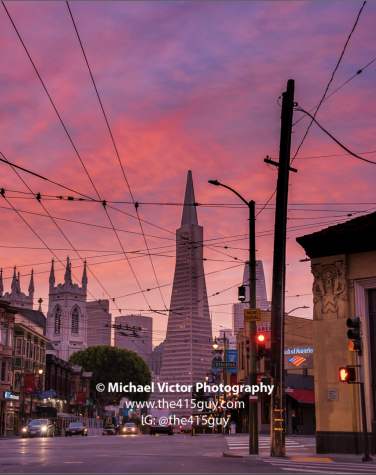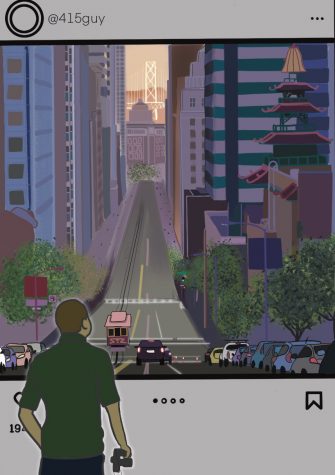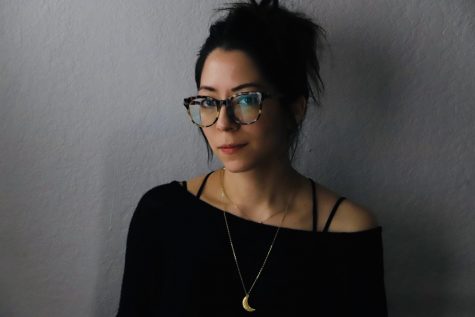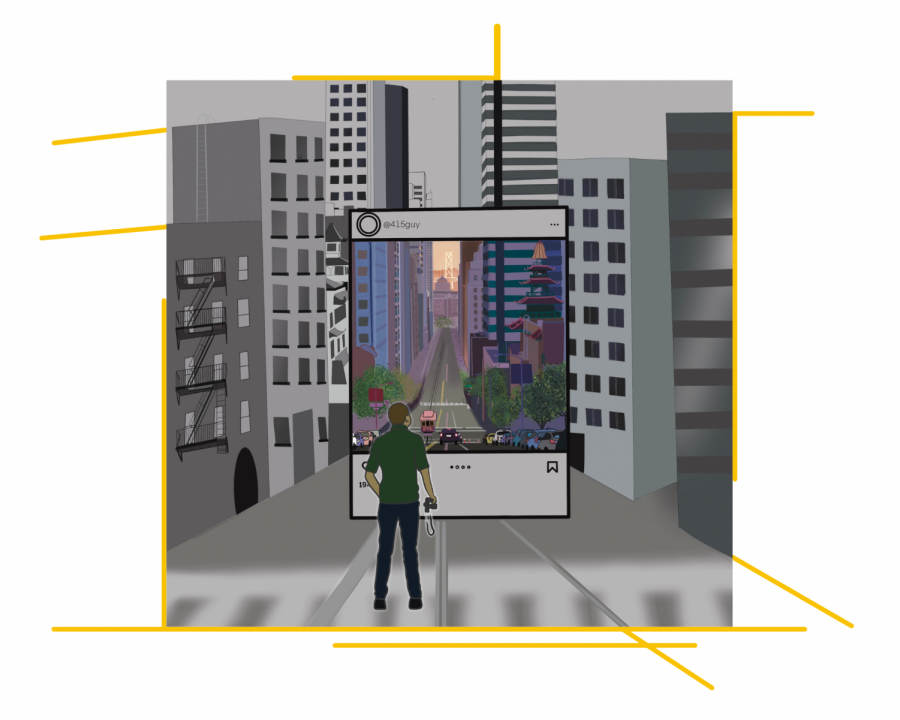Social media: One user’s loss of identity
Following the breakup of his 12-year relationship in 2016, a then 36-year-old Michael Victor walked outside his San Francisco home with a camera in hand, which unknowingly was the start of a new identity.
“My love of photography was reborn after my long-term relationship ended,” said Victor.
As a way to cope, Victor took walks after work with his camera to capture unique perspectives of different neighborhoods throughout the city.
Not only did Victor’s newfound passion for photography lead him up steep hills in the city, but it also steered him toward roughly 75,000 followers on Instagram.
On April 27, after five years as @415guy on Instagram, Victor suspended his account.
“It’s really consumed my identity. Everyone knows me as the @415guy now. I began to realize that people want to meet me because I’m the @415guy. They don’t know Michael,” said Victor. “I need to work on separating these two identities. There’s @415guy, and there’s Michael; they’re two different beings. But for five years, it’s been the same thing.”
Becoming @415guy
Victor’s love for photography started as an 8-year-old child when his parents gifted him their old Nikon 35mm camera.
“I’ve always been into photography,” said Victor. “Not to the extent that I have been doing it, but you know, just random photos around the city when we go places and whatnot, architectural shots.”
As he ventured out into the city with his newfound freedom, Victor nostalgically sent the pictures he took to friends and family. After receiving positive responses, his sister encouraged him to start an Instagram account. With no presence or experience on any social media platform due to being a private person, Victor was hesitant to use his real name; with the help of his sister, he found one.
“She was like, ‘Well if you’re gonna take San Francisco photos, what about the @415guy?’ said Victor.

Being a third-generation San Franciscan, Victor is no stranger to the city. After work, he would drive to a new neighborhood to photograph and post on his page.
“You really got a flavor of the city,” said Victor. “I was gaining followers because it was that unique perspective of a native San Franciscan who is showing more than just the Golden Gate Bridge. I’m actually going into neighborhoods and showing what city life is really like.”
With his rise in followers using hashtags and consistent content, Victor started contributing to articles at SFGate.
It wasn’t until the summer of 2017, when the San Francisco Chronicle wrote a feature on Victor, that his followers increased tremendously.
“Literally, I think in one day, I gained like, 9,000 followers,” said Victor.
Victor was soon flooded with not only followers but the realities of running a successful social media page.
“The more followers you have, the more comments you get, the more engagement you get, the more people that are sharing your photos, the more your photos appear in explorer feeds, and hashtag searches and hashtag queries,” said Victor. “That was really the progression.”
Last year, Adobe held a significant campaign for one of their Lightroom apps and chose three photographers from around the country to work with them.
“I was one [of them],” said Victor.
Prior to becoming @415guy, Victor had no presence on social media, nor any desire. He did find that running a successful page, which led to notoriety and career opportunities, was gratifying.
“Personally, it’s almost like a dopamine effect,” said Victor. “I might be bored one day, then I look at my phone, and I’m like, ‘Oh, wow, NatGeo travel mentioned you in a comment.’ It’s like, ‘Oh, wow, I got featured on National Geographic travel, and they’ve got 19.6 million followers.’ Who doesn’t like to be appreciated for what they do?”
A disconnected identity
Since the mid-90s, social media platforms continue to make their mark on our society. Each decade produces new platforms for people to engage with one another and express their identity.
“The one thing that’s universal is the desire to share,” said Mark Hoffman, assistant professor of Sociology at Stanford.
According to a new national survey of 1,502 U.S. adults conducted by the Pew Research Center, roughly seven in ten people have used social media sites, with YouTube and Facebook leading social media platforms.
The survey also found that “seven in ten Facebook users say they use the site daily, including 49% who say they use the site several times a day.”
According to Pew Research Center, the pattern is similar for Instagram – 73% of 18-to 29-year-old Instagram users say they visit the site every day, with roughly 53% reporting they do so several times per day.
Hoffman’s research focuses on computational social science. According to the Annual Review of Sociology, computational social science “applies computational methods to novel sources of digital data such as social media, administrative records, and historical archives to develop theories of human behavior.”
“It’s [social media] not just that it has this kind of independent effect on us that we don’t control. It’s not just from the outside; we’re part of it,” said Hoffman. “One thing that all social media, and much of the internet, depends on is a desire to share with others, which is a kind of fundamental human aspect that we kind of exploit. That fundamental human desire gets taken to an extreme.”
While his success as @415guy led to roughly 75,000 followers, Victor felt the weight of follower’s expectations diminish his creativity.

“At the same time, as an artist, you begin to feel more confined,” said Victor. “After a while, you begin to see what people like and what your audience likes. It begins to affect how you see things, what you see and what you share.”
However demanding social media can be for someone who wants to disconnect, it’s difficult not to acknowledge the universal influence over us as individuals and as a society.
“The ability to connect with people, the ability to meet people from around the city, around the world. I mean, it’s crazy,” said Victor. “People follow me in Iceland and Africa. It’s just the weirdest thing, but it’s a very powerful tool.”
Akin to an actor having an audience when they perform, successful social media accounts typically have many followers who become their personal audience. It’s easy to not equate followers with an audience because social media began as a way to connect with friends and family.
“I’ve long since realized what the reality is, but at first I wasn’t able to distinguish between people following the @415guy, San Francisco photos and people following Michael, the person,” said Victor.
Not being able to distinguish between followers interested in his photography versus him as a person, Victor’s friends felt compelled to point out the distinctions.
“Friends began to tell me, ‘They don’t know anything about you. They follow you because they like your photography. You take nice photos of the city, you say nice things, and they like the photos. They don’t know you the person,’” said Victor. “I definitely came to realize that, but it can be lonely. Seventy-five thousand people, but I’m not close with any of them.”
Each new follower brought a new revelation, and each new revelation brought Victor closer toward realizing the truth behind his use of social media.
“I realized I’m basically using this app to fulfill all of my needs and that’s not healthy. It should just be a place where I share photos of things I love,” said Victor.
When generating a social media account, choosing a username, followers, who to follow, what to post, what to like and what to comment on is all part of creating your online world.
According to Hoffman, “In many ways, we build the type of social media that we want to see. There’s always been a clear divide between the online world and the real world, but the line seems to be becoming more blurred.
Hoffman discussed moments in his childhood when his mother tried to convince him to play outside instead of playing online video games with his friends.
“It always was weird because the online space was a space in which I was interacting with people. It’s not like it was somehow less interactive, per se than in person,” said Hoffman. “There’s this sort of mindset that there’s this offline world in this online world. I think what’s interesting is how much they’re becoming intertwined.”
According to their website, the Media Psychology Review Center focuses on examining the ways people consume, produce and distribute information in all forms of media through research and assessments.
A 2016 theoretical analysis on Simulated Identities found that “identity is no longer a concept that gradually evolves. Rather, it is a ‘conscious’ process that we are able to construct through social media.”
Their analysis further stated that “identity construction in social media deconstructs the grand narrative of a single identity an individual has in the actual/physical world…In this regard, identity is reconstructed over and over again in a continuous process controlled by individuals.”
Social media gives us the freedom to express the nuances of our identity. In Victor’s experience, he found it to be very limiting.
“These past five years, I really haven’t taken the time just to be me. It’s all about taking photos that people like and generating content,” said Victor. “Not that I don’t enjoy that – I do, but I think I’ve been so focused on it. Honestly, it’s affected my identity.
According to the Media Psychology Review Center, “Simulated identities should not be disregarded or underestimated because, in today’s growing web of social media platforms, it is expected that new media will provide new realities that are of virtual grounding. These new realities […] will shift the hierarchical positions of the binaries of the real over the virtual.”
Re-identifying Michael
While Victor takes a step back from social media and being the @415guy, he acknowledges that the consequences of his social media presence were his own doing.
“No one is pressuring [me] to do anything, but most of my life is spent in the city,” said Victor. “I would like to go to other areas, explore other parts of the Bay Area, and travel more. I feel like much of my life has focused around photographing the city that I haven’t spent much time doing [traveling outside the city].”
Besides his love of photography, Victor is passionate about interior design and plans to redirect his focus to renovating his home into a vintage, retro aesthetic.
“The house was built in 1939. My goal is when you walk into the kitchen, it will look like you step back into the early 1940s.”

After only a few days of suspending his account, Victor expressed that he already feels at ease.
He plans to return to Instagram to reopen his account in the future, but only when he can get back to the person, he once was.
“I want to get back to those carefree days where I don’t care what I share,” said Victor. “I’m not there right now… I want to be true to myself. I’m not using social media as the be-all; end-all my source for everything. My source for happiness and self-confidence and esteem and relationships and dating; I don’t want all that. That’s what I hope to get out of it; separating out the identities.”
Update: As of press time, @415guy has reactivated his account.

Kristen Luna, 35, is a senior photojournalism and philosophy student based in Oakland, CA. As a previous ProPublica Emerging Reporter, Luna strives to...


